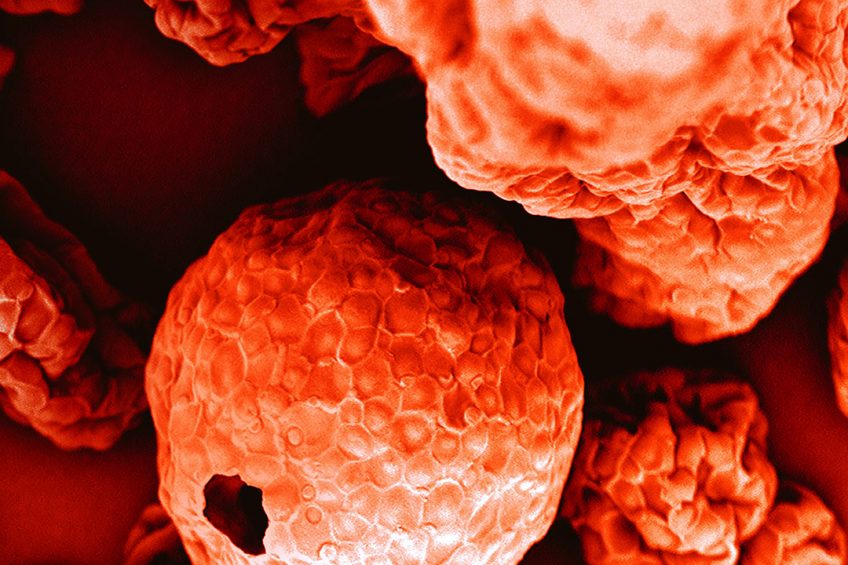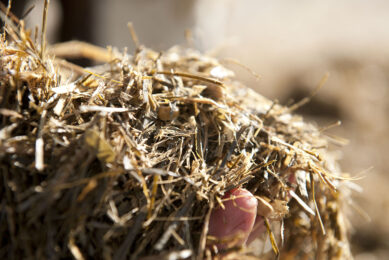Yeast fractions can mitigate the risk of zearalenone

Yeast fractions have shown to be an effective solution to minimise the negative effects of certain mycotoxins. What makes YCW’s effective as mycotoxin adsorbents?
Mechanism of mycotoxin adsorption
The interactive mechanism between yeasts and mycotoxins is complex, being determined by the structure and composition of their respective cell walls. A yeast cell wall is composed of mannoproteins, β1.3 and β1.6 glucans, and a small amount of chitin, creating a layered structure of about 100-200 nm thick. The outer layer of glycoproteins overhangs the inner layer. This is made of β-glucans linked with chitin and mannoproteins to create a fibrous network structure. Wall composition and degree of cross-linking is highly variable depending on growth conditions and the selected yeast strain. Studies of the role these chemical components play in the formation of complexes between YCW’s and mycotoxins have shown that not only β-glucans, but also some mannoproteins and some proteins, are involved in binding to mycotoxins. Interactive forces between mycotoxins and yeasts have also been identified as involving both hydrophobic and electrostatic interactions with weak hydrogen and van der Waals bonds. Thereby, cell walls exhibit numerous different and easy access adsorption centres for mycotoxins. Another important feature of mycotoxin adsorption concerns the physical adsorbent structure of the process, i.e., the total distribution of load, the dimensions of pores, and the available surface area. Several studies have highlighted the importance of the thickness of the yeast cell wall for mycotoxin adsorption. Most importantly, the interaction between chemical components and the structure of YCW’s, impacts the YCW’s three-dimensional structure. This seems to be a critical parameter in the adsorption process. On the other hand, adsorbing mycotoxins have a major part to play in relation to such areas as polarity, solubility, form, and load distribution.
Not all YCW’s are the same
YCW’s are highly variable in composition and structure. As such, their mycotoxin adsorption capacity is greatly influenced by the selected strain’s nature, method, and medium, as used for biomass production and for drying after harvesting. The fermentation of the selected yeast (carbon source, nutrient and oxygen availability, pH, temperature, …) greatly influences the composition of YCW’s and their structure (degree of branching, length of β-glucans chains, etc.), thereby impacting their three-dimensional structure. The selected yeast species, and even the individual yeast strains that are used, affect the composition of YCW’s. Spent yeasts from breweries, distilleries and bioethanol production plants have traditionally been used as raw materials to produce YCW’s for animal feed. The negative aspect of this approach is that these YCW’s are by-products of a previously completed process and often differ greatly from batch to batch. Modern specific screening processes allow YCW’s to be selected according to their high adsorbing capacity and affinity for mycotoxins, all produced from primary culture. In addition, YCW’s which are obtained by a 2-process autolysis or hydrolysis will have different consequences concerning the structure of the cell wall.
Tackling zearalenone and ochratoxin A
In vitro analysis of mycotoxin adsorption is a very useful tool for the rapid screening and identification of agents that may have mycotoxin sequestering potential. Existing methods range from single-concentration studies and isotherm studies to more complex set-ups, such as gastro-intestinal tract models. Nevertheless, the best way to evaluate mycotoxin adsorbents is with in vivo experiments, using specific biological markers, such as tissue residues or changes in biochemical parameters. Safwall is produced from a primary baker’s yeast which has been developed specifically for mycotoxin adsorption, with testing carried out according to the previously described process.
Table 1 – Efficacy of Safwall in adsorbing ZEA.
| Conditions | Results | |
|---|---|---|
| In vitro single concentration study | Incubation at 37°C, pH3 and pH7, 1ppm ZEA | 76% adsorption at pH3 80% adsorption at pH7. |
| In vitro isotherm study | Incubation at 37°C, pH 3 or 7, ZEA concentrations ranging from 100ppb to 20ppm. |  Isotherm of ZEA adsorption on different YCW’s (different composition, strain, origin, and structure). Isotherm of ZEA adsorption on different YCW’s (different composition, strain, origin, and structure). |
| In vitro conditions simulating GIT | Incubation at 39°C, one step mimicking the stomach at pH 2.5 followed by intestine at pH 6.5, 1ppm ZEA. | 78% adsorption. |
| In vivo toxicokinetic study in broiler chickens | Cross-over design, ZEA (5mg/kg BW) administered orally with or without the YCW (0.2 or 0.5g/kg BW). Plasma concentrations of ZEA and metabolites quantified by LC-MS. | Bioavailability reduced by more than 90% for 0.5g/kg BW Safwall dosage and by 60% for the dose 0.2g/kg BW. |
| In vivo trial in gilts | Trial period of 28 days. 600µg ZEA/kg feed. Parameters measured: vulva size, organs weight, ZEA and metabolites content in liver. | Vulva size and relative weight of reproductive organs increased due to ZEA but decreased to control value with Safwall addition. ZEA, α-ZEL and β-ZEL content decreased in liver in presence of Safwall compared to ZEA treatment alone. |
Table 1 summarises the different experiments undertaken to demonstrate the effectiveness of the product in reducing Zearalenone (ZEA) exposure and, consequently, ZEA toxic effects in animals.
- In the first experiment, involving a single-concentration or an isotherm study, Safwall bound 80% of ZEA at pH7.
- In the second experiment, Safwall-ZEA’s complex stability was tested in conditions which simulated a gastro-intestinal environment (GIT). The complex was found to be stable in solutions of pepsin and pancreatin, remaining 78% bound after 2 hours incubation at pH 2.5, followed by 4 hours incubation at pH 6.5.
- The third experiment consisted of a toxicokinetic study of ZEA and its metabolite β-Zearalenol, following the administration to broiler chickens of ZEA and the YCW in an oral bolus. Here, the product was able to reduce the bioavailability of the toxins by 90%. In the last experiment, in which gilts were given ZEA naturally contaminated feed, the addition of Safwall to the diet resulted in the reversal of the ZEA-induced changes in genital organ parameters (vulva size and weight of reproductive organs) as well as reducing ZEA, α-ZEL and β-ZEL levels in the liver. Similarly, the product was shown to be effective in binding ochratoxin A. .
Conclusion
Safwall is an ecofriendly and biosafe strategy for eliminating mycotoxins in animal feed. The product is compatible with other adsorbents and all types of feed, whatever the process. Its efficiency in reducing animal exposure to ZEA and ZEA toxic effects has been demonstrated in vitro and in vivo. Moreover, YCW’s may have other positive functions, such as binding pathogens and improving animal immunity, both of which indirectly helps to control mycotoxin hazards. References available on request.







